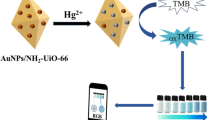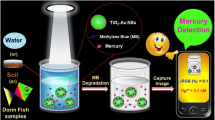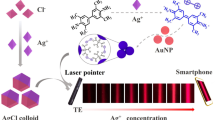Abstract
This work describes two new colorimetric nanosensors for label-free, equipment-free quantitative detection of nanomolar copper (II) (Cu2+) and mercury (II) (Hg2+) ions. Both are based on the analyte-promoted growth of Au nanoparticles (AuNPs) from the reduction of chloroauric acid by 4-morpholineethanesulfonic acid. For the Cu2+ nanosensor, the analyte can accelerate such a redox system to rapidly form a red solution containing dispersed, uniform, spherical AuNPs that is related to these particles’ surface plasmon resonance property. For the Hg2+ nanosensor, on the other hand, a blue mixture consisting of aggregated, ill-defined AuNPs with various sizes can be created, showing a significantly enhanced Tyndall effect (TE) signal (in comparison with that produced in the red solution of AuNPs). By using a timer and a smartphone to quantitatively measure the time of producing the red solution and the TE intensity (i.e., the average gray value of the corresponding image) of the blue mixture, respectively, the developed nanosensors are well demonstrated to achieve linear ranges of 6.4 nM to 100 μM and 6.1 nM to 1.56 μM for Cu2+ and Hg2+, respectively, with detection limits down to 3.5 and 0.1 nM, respectively. The acceptable recovery results obtained from the analysis of the two analytes in the complex real water samples including drinking water, tap water, and pond water ranged from 90.43 to 111.56%.
Graphical abstract





Similar content being viewed by others
References
Najafi M, Abednatanzi S, Derakhshandeh PG, Mollarasouli F, Bahrani S, Behbahani ES, et al. Metal-organic and covalent organic frameworks for the remediation of aqueous dye solutions: adsorptive, catalytic and extractive processes. Coord Chem Rev. 2022;454:214332–61. https://doi.org/10.1016/j.ccr.2021.214332.
Naimabadi A, Gholami A, Ramezani AM. Determination of heavy metals and health risk assessment in indoor dust from different functional areas in Neyshabur. Iran Indoor Built Environ. 2021;30(10):1781–95. https://doi.org/10.1177/1420326X20963378.
Zamora-Ledezma C, Negrete-Bolagay D, Figueroa F, Zamora-Ledezma E, Ni M, Alexis F, et al. Heavy metal water pollution: a fresh look about hazards, novel and conventional remediation methods. Environ Technol Innov. 2021;22:101504–29. https://doi.org/10.1016/j.eti.2021.101504.
Mitra S, Chakraborty AJ, Tareq AM, Emran TB, Nainu F, Khusro A, et al. Impact of heavy metals on the environment and human health: novel therapeutic insights to counter the toxicity. J King Saud Univ Eng Sci. 2022;34(3):101865–85. https://doi.org/10.1016/j.jksus.2022.101865.
Zhai B, Huang K, Wang H, Su D, Xu Y. Highly sensitive and selective copper (II)-catalyzed dual-DNAzyme colorimetric biosensor based on exonuclease III-mediated cyclical assembly. Catalysts. 2021;11(11):1352–60. https://doi.org/10.3390/catal11111352.
Tian C, Zhao L, Zhu J, Zhang S. Ultrasensitive detection of trace Hg2+ by SERS aptasensor based on dual recycling amplification in water environment. J Hazard Mater. 2021;416:126251–6. https://doi.org/10.1016/j.jhazmat.2021.126251.
Surucu O. Electrochemical removal and simultaneous sensing of mercury with inductively coupled plasma-mass spectrometry from drinking water. Mater Today Chem. 2022;23:100639–46. https://doi.org/10.1016/j.mtchem.2021.100639.
Wu M, Zhi M, Liu Y, Han J, Qin Y. In situ analysis of copper speciation during in vitro digestion: differences between copper in drinking water and food. Food Chem. 2021;371:131388–94. https://doi.org/10.1016/j.foodchem.2021.131388.
Deng Z, Jin W, Yin Q, Huang J, Huang Z, Fu H, et al. Ultrasensitive visual detection of Hg2+ ions via the Tyndall effect of gold nanoparticles. Chem Commun. 2021;57(21):2613–6. https://doi.org/10.1039/D0CC08003A.
Pekou A, Manousi N, Zachariadis GA. Multielemental method for maternal breast milk analysis by inductively coupled plasma – atomic emission spectrometry (ICP-AES) and acid digestion. Anal Lett. 2022;55:1–11. https://doi.org/10.1080/00032719.2022.2081975.
Yurak V, Apakashev R, Dushin A, Usmanov A, Lebzin M, Malyshev A. Testing of natural sorbents for the assessment of heavy metal ions’ adsorption. Appl Sci. 2021;11:8–17. https://doi.org/10.3390/app11083723.
Xu C, He M, Chen B, Hu B. Magnetic porous coordination networks for preconcentration of various metal ions from environmental water followed by inductively coupled plasma mass spectrometry detection. Talanta. 2022;245:123470–7. https://doi.org/10.1016/j.talanta.2022.123470.
Gan W, Shi W, Su Q. Simultaneous determination of trace mercury and cadmium in tobacco samples by cold vapor generation-atomic fluorescence spectrometry. J Anal At Spectrom. 2004;19:911–6. https://doi.org/10.1039/B402545H.
Li KF, Syue PC, Lien CY, Ku KL. Simultaneous analysis of 16 metal ions by ion-pairing high-performance liquid chromatography-electrospray ionization tandem mass spectrometry. J Chin Chem Soc. 2022;69(10):1754–64. https://doi.org/10.1002/jccs.202200303.
Wang L, Cheng Y, Lamb D, Chen Z, Lesniewski PJ, Megharaj M, et al. Simultaneously determining multi-metal ions using an ion selective electrode ar-ray system. Environ Technol Innov. 2016;6:165–76. https://doi.org/10.1016/j.eti.2016.10.001.
Slevin PJ, Györy-Szebényi E, Svehla G. Application of displacement reactions in flame photometry—II: emission flame photometric determination of alkaline earth metals in the presence of interfering anions. Talanta. 1972;19(3):307–15. https://doi.org/10.1016/0039-9140(72)80081-X.
Wang X, Qin Y, Qin J, Yang Y, Qi T, Chen R, et al. The interaction laws of atmospheric heavy metal ions and water-soluble organic compounds in PM2.5 based on the excitation-emission matrix fluorescence spectroscopy. J Hazard Mater. 2021;402:123497–504. https://doi.org/10.1016/j.jhazmat.2020.123497.
Qiu J, Zeng D, Lin Y, Ye W, Chen C, Xu Z, et al. Carbon-polymer dot-based UV absorption and fluorescence performances for heavy metal ion detection. Spectrochim Acta A Mol Biomol Spectrosc. 2023;285:121913–22. https://doi.org/10.1016/j.saa.2022.121913.
Xu G, Song P, Xia L. Examples in the detection of heavy metal ions based on surface-enhanced Raman scattering spectroscopy. Nanophotonics. 2021;10:4419–45. https://doi.org/10.1515/nanoph-2021-0363.
Ding Q, Li C, Wang H, Xu C, Kuang H. Electrochemical detection of heavy metal ions in water. Chem Commun. 2021;57:7215–31. https://doi.org/10.1039/D1CC00983D.
Mo X, Huang J, Sun Y, Chen X, Deng Y, Liu C, et al. Simple, rapid, portable and quantitative sensing of Fe3+ ions via analyte-triggered redox reactions mediating Tyndall effect enhancement of Au nanoparticles. Microchem J. 2022;174:107075–82. https://doi.org/10.1016/j.microc.2021.107075.
Sun Y, Yuan K, Mo X, Chen X, Deng Y, Liu C, et al. Tyndall-effect-inspired assay with gold nanoparticles for the colorimetric discrimination and quantification of mercury ions and glutathione. Talanta. 2022;238:122999–3005. https://doi.org/10.1016/j.microc.2021.107075.
Chen G, Chen W, Yen Y, Wang C, Chang H, Chen C. Detection of mercury(II) ions using colorimetric gold nanoparticles on paper-based analytical devices. Anal Chem. 2014;86(14):6843–68. https://doi.org/10.1021/ac5008688.
Yu L, Pang Y, Mo Z, Huang Y, Shen X. Coordination array for accurate colorimetric sensing of multiple heavy metal ions. Talanta. 2021;231:122357–64. https://doi.org/10.1016/j.talanta.2021.122357.
Zhu J, Shen J, Hu B, Yang L, Jiang C. Chromaticity evolutionary detection of food contaminant semicarbazide through an upconversion luminescence-based nanosensor. Anal Chem. 2021;94(2):1126–34. https://doi.org/10.1021/acs.analchem.1c04207.
Nazifi M, Ramezani AM, Absalan G, Ahmadi R. Colorimetric determination of D-penicillamine based on the peroxidase mimetic activity of hierarchical hollow MoS2 nanotubes. Sens Actuators B Chem. 2021;332:129459. https://doi.org/10.1016/j.snb.2021.129459.
Nazifi M, Ahmadi R, Ramezani AM, Absalan G. Introducing hierarchical hollow MnO2 microspheres as nanozymes for colorimetric determination of captopril. Anal Bioanal Chem. 2021;413:7063–72. https://doi.org/10.1007/s00216-021-03672-2.
Malaei R, Ramezani AM, Ahmadi R, Absalan G. Colorimetric analysis of captopril on the basis of its free radical scavenger character with carbon nanozymes as catalyst. Arab J Sci Eng. 2022;1–8. https://doi.org/10.1007/s13369-022-07489-8
Dzantiev BB. Gold nanoparticles functionalized with mercaptosuccinic acid as a means for detecting Fe(III) ions. Chem Proceedings. 2021;5:6–11. https://csac2021.sciforum.net/.
Hu Y, Huang Z, Liu B, Liu J. Hg(II) adsorption on gold nanoparticles dominates DNA-based label-free colorimetric sensing. Nano Mater. 2021;4:1377–85. https://doi.org/10.1021/acsanm.0c02923.
Huang J, Mo X, Fu H, Sun Y, Zhang Y. Tyndall-effect-enhanced supersensitive naked-eye determination of mercury (II) ions with silver nanoparticles. Sens Actuators B Chem. 2021;344:130218–24. https://doi.org/10.1016/j.snb.2021.130218.
Chen X, Sun Y, Mo X, Gao Q, Deng Y, Hu M, et al. On-site, rapid and visual method for nanomolar Hg2+ detection based on the thymine–Hg2+–thymine triggered “double” aggregation of Au nanoparticles enhancing the Tyndall effect. RSC Adv. 2021;11(58):36859–65. https://doi.org/10.1039/D1RA07211K.
Hsiao M, Chen S-H, Li J-Y, Hsiao P-H, Chen C-Y. Unveiling the detection kinetics and quantitative analysis of colorimetric sensing for sodium salts using surface-modified Au-nanoparticle probes. Nanoscale Adv. 2022;4(15):3172–81. https://doi.org/10.1039/D2NA00211F.
Diamanti S, Elsen A, Naik R, Vaia R. Relative functionality of buffer and peptide in gold nanoparticle formation. J Phys Chem C. 2009;113(23):9993–7. https://doi.org/10.1021/jp8102063.
Sander LM. Diffusion-limited aggregation: a kinetic critical phenomenon? Contemp Phys. 2000;41(4):203–18. https://doi.org/10.1080/001075100409698.
Lewis GG, DiTucci MJ, Phillips ST. Quantifying analytes in paper-based microfluidic devices without using external electronic readers. Angew Chem Int Ed. 2012;51(51):12707–10. https://doi.org/10.1002/ange.201207239.
Wang Y, Gunasekaran S. Spectroscopic and microscopic investigation of gold nanoparticle nucleation and growth mechanisms using gelatin as a stabilizer. J Nanopart Res. 2012;14(10):1200–10. https://doi.org/10.1007/s11051-012-1200-2.
Lu H, Li J, Zhang M, Wu D, Zhang Q. A highly selective and sensitive colorimetric uric acid biosensor based on Cu(II)-catalyzed oxidation of 3,3′,5,5′-tetramethylbenzidine. Sens Actuators B Chem. 2017;244:77–83. https://doi.org/10.1016/j.snb.2016.12.127.
Ge C, Luo Q, Wang D, Zhao S, Liang X, Yu L, et al. Colorimetric detection of copper(II) ion using click chemistry and hemin/G-quadruplex horseradish peroxidase-mimicking DNAzyme. Anal Chem. 2014;86(13):6387–92. https://doi.org/10.1021/ac501739a.
Fang Y, Song J, Chen J, Li S, Zhang L, Chen G, et al. Gold nanoparticles for highly sensitive and selective copper ions sensing-old materials with new tricks. J Mater Chem. 2011;21(22):7898–900. https://doi.org/10.1039/c1jm10771b.
El-Nahhal IM, Zaggout FR, El-Ashgar NM. Uptake of divalent metal ions (Cu2+, Zn2+ and Cd2+) by polysiloxane immobilized glycinate ligand system. Anal Lett. 2000;33(15):3373–95. https://doi.org/10.1080/00032719.2000.10399507.
Yang F, Lin D, Pan L, Zhu J, Shen J, Yang L, et al. Portable smartphone platform based on a single dual-emissive ratiometric fluorescent probe for visual detection of isopropanol in exhaled breath. Anal Chem. 2021;93(43):14506–13. https://doi.org/10.1021/acs.analchem.1c03280.
Jiang R, Lin D, Zhang Q, Li L, Yang L. Multiplex chroma-response based fluorescent smartphone sensing platform for rapid and visual quantitative determination of antibiotic residues. Sens Actuators B Chem. 2022;350:130902–9. https://doi.org/10.1016/j.snb.2021.130902.
Zhang Q, Zhang Z, Xu S, Da L, Lin D, Jiang C. Enzyme-free and rapid visual quantitative detection for pesticide residues utilizing portable smartphone integrated paper sensor. J Hazard Mater. 2022;436:129320–9. https://doi.org/10.1016/j.jhazmat.2022.129320.
Li L, Yang L, Lin D, Xu S, Mei C, Yu S, et al. Hydrogen-bond induced enhanced emission ratiometric fluorescent handy needle for visualization assay of amoxicillin by smartphone sensing platform. J Hazard Mater. 2023;444:130403–11. https://doi.org/10.1016/j.jhazmat.2022.130403.
Funding
This work was financially supported by the National Natural Science Foundation of China (Nos. 21874032 and 21765007), the Central Government-Guided Local Science and Technology Development Project (No. GuikeZY20198006), and the Guangxi Science Fund for Distinguished Young Scholars (No. 2018GXNSFFA281002).
Author information
Authors and Affiliations
Corresponding authors
Ethics declarations
Conflict of interest
The authors declare no competing interests.
Additional information
Publisher's note
Springer Nature remains neutral with regard to jurisdictional claims in published maps and institutional affiliations.
Supplementary Information
Below is the link to the electronic supplementary material.
Rights and permissions
Springer Nature or its licensor (e.g. a society or other partner) holds exclusive rights to this article under a publishing agreement with the author(s) or other rightsholder(s); author self-archiving of the accepted manuscript version of this article is solely governed by the terms of such publishing agreement and applicable law.
About this article
Cite this article
Hua, F., Pan, F., Yang, J. et al. Quantitative colorimetric sensing of heavy metal ions via analyte-promoted growth of Au nanoparticles with timer or smartphone readout. Anal Bioanal Chem 415, 2705–2713 (2023). https://doi.org/10.1007/s00216-023-04669-9
Received:
Revised:
Accepted:
Published:
Issue Date:
DOI: https://doi.org/10.1007/s00216-023-04669-9




